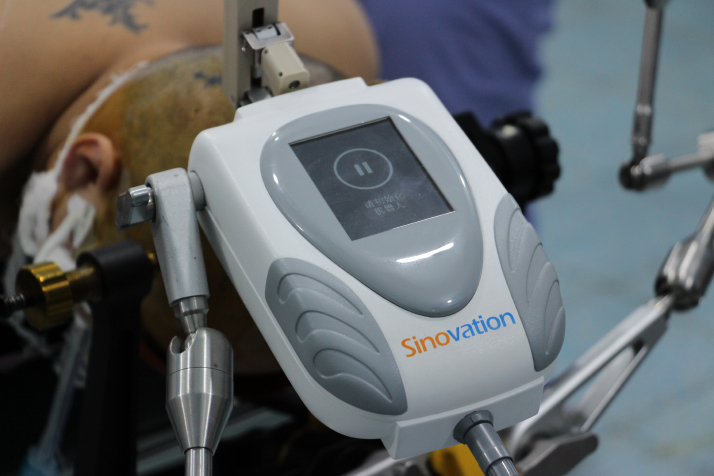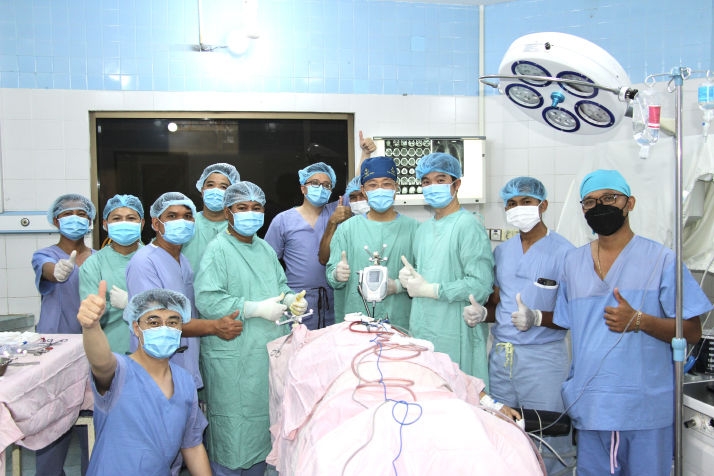| China |
| Digital technological advancements propel Chinese medical innovations | |
|
|
|
A transnational "cloud surgery" took place in Preah Ket Mealea Hospital in Phnom Penh, Cambodia, on April 29 for a patient suffering a brain hemorrhage. It is the country's first-ever robot-assisted neurosurgery. The surgery was conducted under the remote guidance of Professor Hou Lijun from the Second Affiliated Hospital of the Naval Medical University in China and with the on-site support of an associate chief physician from China, utilizing a neurosurgical mini robot navigation system developed by Sinovation (Beijing) Medical Technology Co. Ltd. (Sinovation).
The surgical team used high-precision robots to draw out 15 ml of dark accumulated blood, relieving the pressure on the nerves caused by the hemorrhage. On the first day after the surgery, the paralysis caused by the hemorrhage was significantly alleviated. An MRI (magnetic resonance imaging) showed the volume of the hemorrhage had reduced significantly.  The Q300 series Neurosurgical Mini Robot Navigation System developed by Sinovation (Beijing) Medical Technology Co. Ltd. (COURTESY PHOTO)
Cooperation between Chinese and Cambodian doctors on the surgery was made possible by advanced medical equipment developed in China and exported overseas. This new tech is not only improving healthcare, but also creating new platforms for international cooperation and exchange.  A group photo after brain hemorrhage surgery in Preah Ket Mealea Hospital on April 29 (COURTESY PHOTO)
Inclusive healthcare The robots used in the surgery come with inbuilt navigation and brain mapping systems that enable 3D modeling of skin, skull, brain tissues and blood vessels, making locating and reaching hemorrhages easier. These new medical devices have been developed in China, making use of image processing technologies, artificial intelligence (AI) and robotics to make neurosurgery more precise and efficient. The country's capacity to independently develop medical technologies instead of relying on those from overseas is reducing diagnostic and treatment costs, making healthcare more inclusive domestically and overseas. "Minimally invasive surgery is needed not only in top-tier hospitals but also in district- and county-level hospitals. Previously, the high cost of robots was a barrier for these hospitals to conduct such surgeries. Now, through independent research and development, we have reduced the price of a mini surgery robot to around 1 million yuan ($138,000), making them affordable for grassroots hospitals," Liu Wenbo, co-founder and chief technology officer of Sinovation, told Beijing Review. According to Liu, the cost of medical devices mainly lies in the cost of the core components (such as robotic arms and sensors), which can account for more than 80 percent of the total cost and the research and development investment. Sinovation mainly imported core components such as robotic arms from Japan until 2018. But now, through collaboration with domestic robotic arm manufacturers, the company has independently developed its own equipment, significantly reducing prices. Currently, the neurosurgical products developed by Sinovation are already in use in nearly 200 hospitals in China. In addition to improving domestic neurosurgical diagnosis and treatment and narrowing regional treatment gaps, China-developed medical devices are also providing efficient treatment solutions for neighboring countries. After completing the surgery in Cambodia, Professor Hou remarked. "In the future, as remote technology further integrates with robotic technology, surgeons will be able to perform precise remote surgeries using robotic technology, even if thousands of miles apart." Becoming a chief surgeon used to require 15 to 20 years of training and experience. However, surgical robot devices greatly reduce the level of experience necessary for doctors to perform procedures. "Using surgical robots can enable grassroots hospitals to match the medical level of top-tier hospitals. Robots can help standardize surgical procedures, ensuring consistent outcomes regardless of the doctor's experience level," Liu added. AI revolution In addition to enabling remote robot-assisted surgeries, AI technology has been employed by Chinese biopharmaceutical companies as a new quality productive force to reduce the time and money it takes to bring new drugs to market. Now, Zhongguancun Science Park's Daxing Biomedical Industry Base in Beijing, known as "China Bio-Medicine Park," is creating an "AI+" pharmaceutical innovation ecosystem. Beijing Hotgen Biotech Co. Ltd. has established an AI-powered new drug research platform at the base. This platform aims to promote AI technology applications in key areas such as drug target identification, drug molecule design and optimization, and clinical trial design and management. Xu Lida, head of the research platform, told Beijing Review that researching new targets is crucial for developing innovative drugs, and using AI technology to analyze vast amounts of data can help discover new mechanisms for treating diseases. To ensure precision, the research platform has both "wet" and "dry" laboratories. Wet labs are traditional biological laboratories, while dry labs use computational algorithms on chips. Computer-produced results are repeatedly verified in wet labs and further optimized on computers. AI-driven new drug research is an interdisciplinary field requiring research and development personnel with backgrounds in information science, pharmaceutical engineering, biotechnology, and more. "Four years ago, we already recognized that AI technology is a crucial technology and began building our team, simultaneously conducting medical research and refining computer algorithms, models and processes. Now, we've experienced the benefits of AI in improving our success rates in drug development," said Lin Changqing, Chairman of Beijing Hotgen Biotech Co. Ltd. Driven by digital technological advancements, Chinese medical science is making unprecedented breakthroughs. From remote surgeries in Cambodia to the extensive use of surgical robots in domestic hospitals and AI-assisted new drug development, China is demonstrating its innovative capabilities. These advancements have lowered costs, enhanced surgical precision, and brought hope to more patients. Copyedited by G.P. Wilson Comments to wangruohan@cicgamericas.com |
|
||||||||||||||||||||||||||||||
|